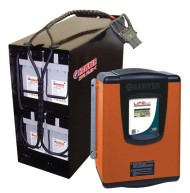 John Lawton, Director of Marketing at EnerSys Motive Power Europe, explains how to get the most from your lift truck batteries and lower the cost of ownership.
John Lawton, Director of Marketing at EnerSys Motive Power Europe, explains how to get the most from your lift truck batteries and lower the cost of ownership.
Batteries are an expensive necessity. If you are going to lower the costs of your material handling operations and ensure that down-time is minimised it pays to understand how to purchase and use your power sources to best advantage.
There are three types of lead-acid battery technologies generally used in material handling equipment: standard design flooded cells, low maintenance flooded cells and maintenance free gel or AGM cells. The latter are best suited to low duty applications with a lower depth of discharge. Inevitably when buying decisions are made the visible expense is for the battery & charger. What are not always understood are the operating & maintenance costs for the life of the product which should be factored in to give a true life-time cost.
For instance flooded batteries require regular topping-up with deionised water. This is likely to be weekly for standard designs and less frequently for low maintenance batteries like Hawker Water Less. The cost of water and the labour required to carry out the process should be added into the purchase decision calculation. Water topping-up is not needed for Hawker XFC Flex maintenance free batteries which are also designed for opportunity charging.
The other operating cost is electricity for recharging your batteries and the amount depends upon the battery technology and the charging system used. Your electricity tariff and the time of charging may also come into the equation. Specifiers and buyers of batteries need to consider all these factors in order to arrive at the true life-time costs.
For those operating intensively on two or three shifts per day battery changing is going to be essential in order to keep the business running effectively. So minimising the time taken to change a lift truck battery will bring significant dividends. The traditional changing methods can take up to ten minutes per change. But with the correct equipment this can be reduced to as little a three minutes for each change. The impact such a reduction in change time can be considerable. A 24/7 operation, with 50 trucks carrying out two battery changes per truck per day, could reduce the total time taken in battery change by 4,200 hours per year. Additionally by using change equipment which maximises floor space it is also possible to reduce the charging area by up to 60%, thereby increasing operational space for increased storage.
For truck operations that are not used intensely, ‘fast charging’ can be considered. This eliminates the need for battery changes because batteries can be charged when the truck is not in operation – during coffee breaks, at lunch times and between shifts, or even during the shift when the truck is standing idle. It may be possible to re-model operations to allow sufficient recharge time while increasing truck uptime. Fast charging is however only suitable for flooded batteries with airmix. Hawker XFC Flex, advanced Thin Plate Pure Lead technology is ideal for fast opportunity charging.
Efficient battery charging brings significant benefits and means less electricity consumption. There are two things which impact the amount of electricity needed to recharge a battery; the charger’s efficiency and the charging factor. Conventional 50Hz charging technology uses large transformers which reduce the efficiency in converting AC input to DC output. Such chargers are typically only 80% efficient – older models can be considerably less. The charging factor is usually 1.20 which means 20% overcharge to mix the electrolyte and return the battery to a fully charged condition. High frequency chargers are >90% efficient and have charging factors of 1.08 to 1.15 depending on the battery technology. Such efficiency can produce a reduction of >15% in electricity consumption thereby not only reducing the carbon footprint but bringing significant financial savings.
For large operations even more savings can be achieved by using a software system like EnerSys PowerNet to manage battery fleet use and charging. By scheduling charging to avoid costly spikes in electricity demands and ensuring the correct rotation of batteries less electricity is required. When all aspects of battery fleet management are operating at optimum efficiency, life-time battery costs can be substantially reduced.
Enersys Motive Power
Karen Smith
Tel: 0161 727 3800




Comments are closed.